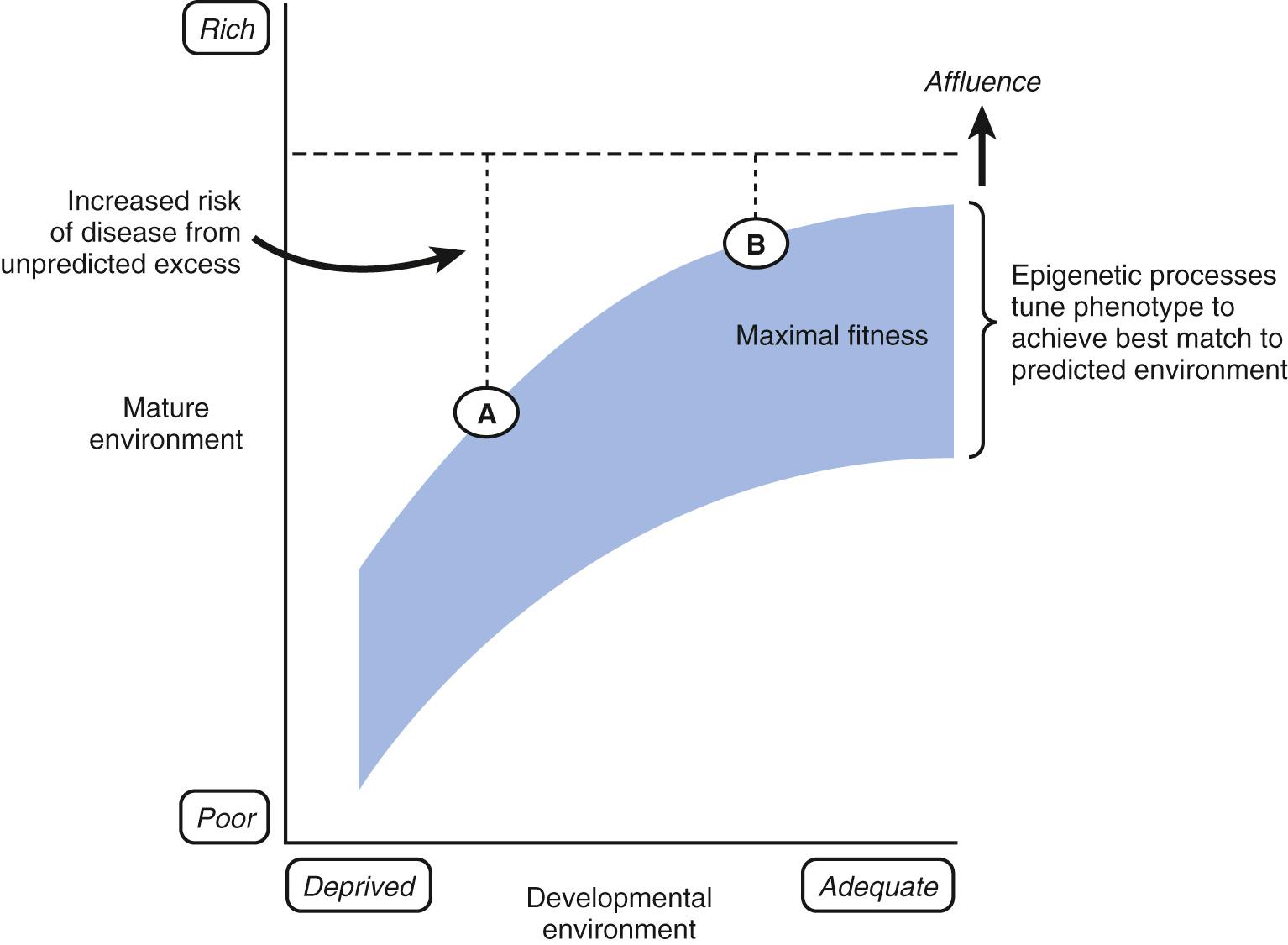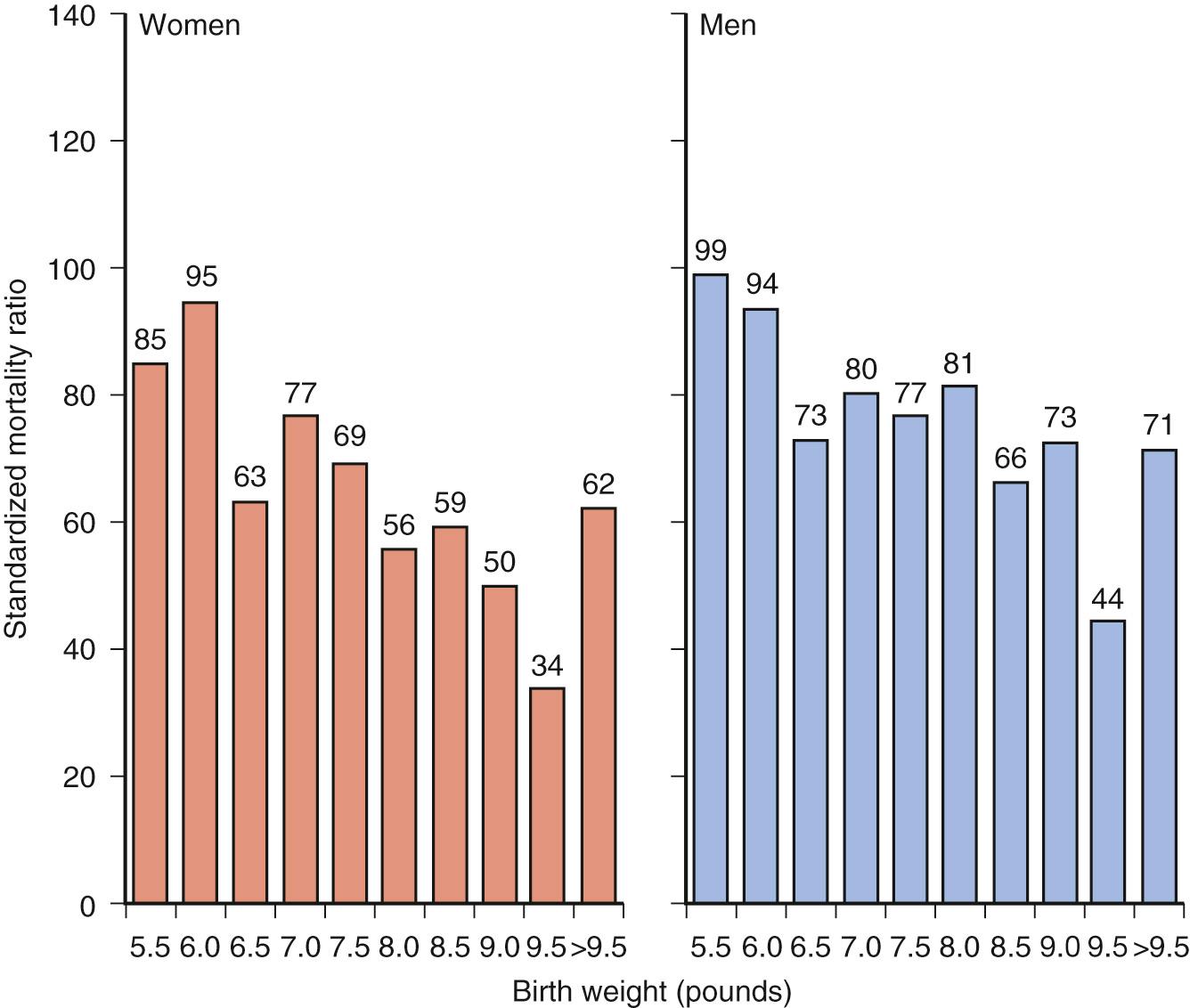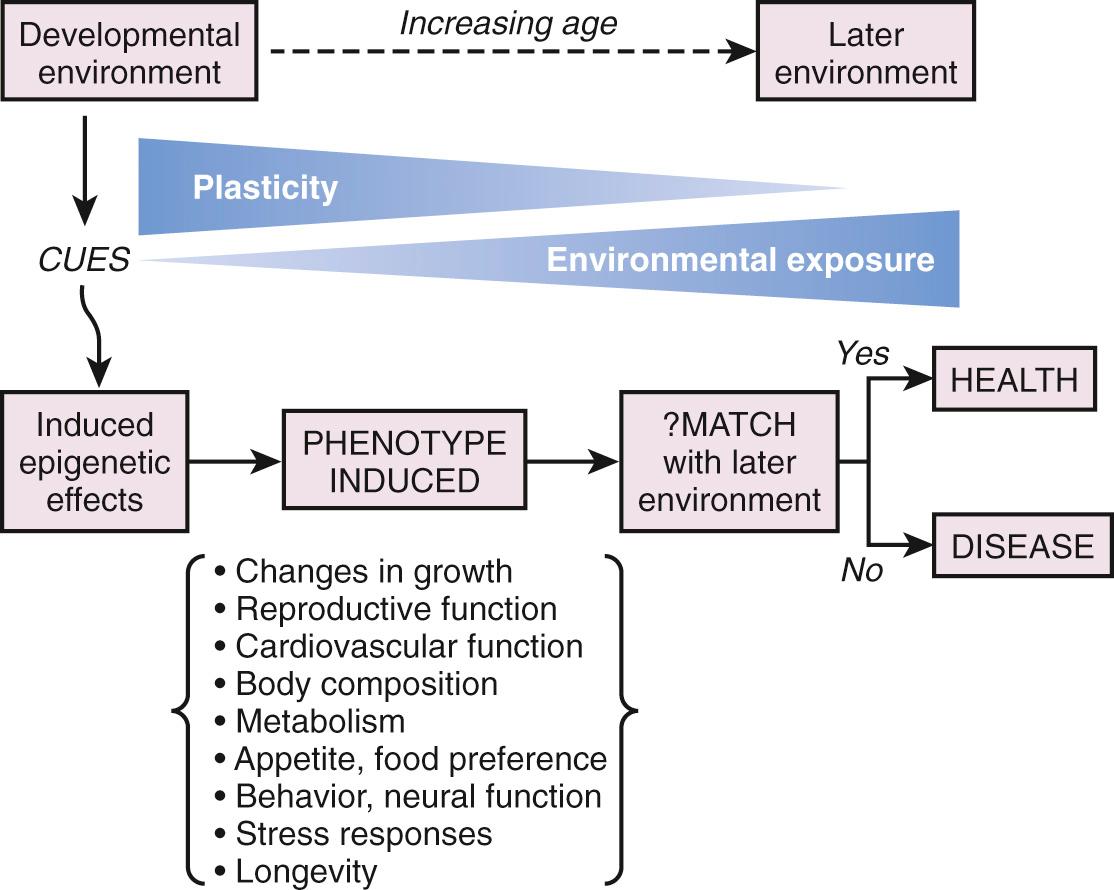Physical Address
304 North Cardinal St.
Dorchester Center, MA 02124
The concept of fetal origins of adult disease popularized by Barker arose from a robust association between small size at birth and the risk of chronic adult diseases, such as coronary artery disease, hypertension, stroke, type 2 diabetes mellitus, and osteoporosis. These original epidemiologic observations have been extensively replicated by multiple groups in varying populations of different ethnicities employing birth weight as a surrogate for the intrauterine state. During the 1944-1945 Dutch famine, women who were previously adequately nourished were subjected to low caloric intake and the associated environmental stressors. The offspring that were conceived or were gestating in their mothers’ wombs during the famine, as adult survivors at age 50-60 years, showed a higher incidence of hypertension, cardiovascular-related mortality and morbidity, and glucose intolerance/insulin resistance. The culmination of all these epidemiologic associations is referred to as the “Barker hypothesis” or “developmental origins of health and disease (DOHaD).”
Although fetal growth and birth weight have served as surrogate markers of fetal nutrition and health, it is clear that fetuses subjected to nutritional perturbations with no resultant change in size or growth also develop adult chronic diseases. Moreover, although in utero calorie restriction serves as a classic example of the far-reaching implications of the “Barker hypothesis,” other triggers, including a deficiency or excess of specific nutrients, stress, inflammation, toxins, and drugs, can perturb the fetal hormonal-metabolic milieu and set the stage for the subsequent onset of chronic diseases. These observations support that adaptations in an adverse in utero environment occur to ensure immediate survival, which may or may not interfere with fetal growth depending on the type, timing, and severity of adversity. Although nutritional deficiency is considered to exist only in poorly resourced countries, differential socioeconomic status with varying access to health care and sociocultural and ethnic differences resulting in disparities are rampant in the Western world, including the United States. These situations can lead to malnutrition, overnutrition, and other forms of maternal-fetal stress, which translate into an altered phenotype of this subpopulation.
As more investigations in human and animal models are accumulating, various mechanisms responsible for this fetal-adult association are being unraveled. These adaptive mechanisms, or “thrifty phenotype,” combat an adverse nutritional and/or metabolic intrauterine environment by developing safeguards for the energy supply sometimes at the expense of growth, ensuring a reduced fetal demand. After birth, these same adaptive systems can remain masked, however, without much contribution to short-term health or disease. Over time, with or without additional nutritional or metabolic stressors, the finely crafted phenotype may tip toward a disease state. The conventional belief is that these phenotypic features are expressed mainly in aging adults. Given lifestyle changes toward an increased caloric intake and relative inactivity, however, some of these features are seen in childhood or during late teenage years ( Box 16.1 ).
Diabetes mellitus
Obesity
Dyslipidemia
Hypertension
Coronary artery disease
Stroke
Kidney disease
Liver disease
Lung abnormalities—reactive airways disease
Immune dysfunction
Polycystic ovarian syndrome, premature pubarche
Osteoporosis
Alzheimer disease
Depression, anxiety, bipolar disorder, schizophrenia
Cancer
Social problems
Poor cognitive performance
Shortened life span
The use of artificial reproductive technology continues to increase worldwide; 1%-3% of live births are secondary to artificial technology. Different culture media and techniques used in artificial reproductive technology can alter the environment of the developing embryo and subsequent phenotype of the offspring. Even after accounting for confounding factors such as infertility and advanced maternal or paternal age, there is evidence that artificial reproductive technology is linked to an increased incidence of prematurity, growth restriction, congenital malformations, and imprinting disorders. Imprinting refers to the differential expression of specific genes according to parental origin. Genes are “silenced” by epigenetic modifications. In pregnancy, imprinted genes play a critical role in determining placental size and fetal growth. Most paternally expressed genes enhance placental and fetal growth, whereas most maternally expressed genes reduce placental and fetal size. Imprinting disorders, such as Beckwith-Wiedemann, Angelman, Prader-Willi syndromes, and hypomethylation syndrome, appear to be increased in children who are a product of artificial reproductive technology. The incidence of Angelman syndrome is estimated to increase from 1 in 400,000 births to 1 in 20,000 births with artificial reproductive technology. Moreover, artificial reproductive technology may alter the growth patterns of children. Children conceived by in vitro fertilization also have decreased growth early in infancy and then experience “catch-up growth” after about 6 months of age, resulting in higher blood pressures and altered body composition. These alterations in growth patterns and risk for disease illustrate that reprogramming at an early stage can increase the risk for adult disease later on.
The first indication that postnatal stages of development can influence the long-term outcome related to perturbed fetal nutrition came from observations during the Leningrad siege. Exposure in utero and postnatally to nutritional deprivation failed to produce signs of chronic diseases in adults. These findings suggested that postnatal manipulation of nutrition may have a protective effect on the trajectory of fetal origins of adult disease. Investigations have revealed that in girls and boys, low birth weight with a slow growth pattern followed by exponential growth during childhood increases the risk for metabolic syndrome, which is characterized by obesity, insulin resistance, hypertension, and dyslipidemia. These studies established that postnatal growth patterns were important in modulating the fetal trajectory toward predetermining the adult phenotype. These findings are of particular interest to neonatology, where there continues to be an ongoing dilemma as to what is ideal postnatal growth and whether this growth rate should be the same for infants of varying birth weights, gestations, sexes, ethnicities, and races.
The phenomenon of postnatal catch-up growth seems to reflect intrauterine or early postnatal nutritional deprivation. It is a normal tendency by the body to compensate after a nutritionally restricted period, showing rapid growth. This rapid growth targets short-term benefits, which include survival and protecting the reproductive capacity. It is evident, however, that catch-up growth tends to favor nutrient deposition in white adipose tissue, resulting in adiposity, particularly visceral adiposity; a rearrangement of skeletal muscle mitochondria; and increased oxidative injury. These changes set the stage for metabolic syndrome, diabetes mellitus, and coronary artery disease as the child matures into an adult. This catch-up growth results in a shortened life span with changes in the telomeric length. For “short-term gain,” catch-up growth results in “long-term pain” ( Fig. 16.1 ).

The question arises, should postnatal catch-up growth not be fostered? If postnatal nutrition matches intrauterine nutrition, can adult chronic diseases be curbed and result in longevity? Although animal and human studies lend credence to this concept, the absence of catch-up growth, although resulting in glucose tolerance, lean body composition, and reduced coronary artery disease with longevity, may negatively affect cognition and reproductive capacity. Rapid postnatal growth, whether superimposed on low birth weight (LBW) or normal birth weight, seems to have a similar effect in producing adult chronic diseases. Avoidance of rapid postnatal catch-up growth within a short period may be beneficial if replaced with moderate long-term growth and may be influenced not only by the amount of calories ingested but also by the quality and composition of the nutrition. In a study of small-for-gestational-age (SGA) infants exposed to either maternal breast milk or formula, babies who received breast milk exhibited decreased adiposity and normal serum adiponectin concentrations, while those who received either standard or protein-enriched formula had increased fat mass and lower adiponectin concentrations. Other studies have revealed an association between fortified formulas and elevated blood pressures and insulin resistance during the childhood years.
At the other end of the spectrum, infants born with a heavier birth weight, resulting from either maternal diabetes or obesity, are also prone to adult chronic diseases. These infants are obese during childhood and develop insulin resistance with the associated phenotypic presentations. One can speculate that these infants experience catch-up growth during fetal life after experiencing slow growth during the early embryonic phase. Further postnatal escalated growth leads to earlier acquisition of adult chronic diseases and the associated complications. The weight status in the first 6 months of life predicts obesity at 3 years of age and future mortality ( Fig. 16.2 ).

Investigations have solidified the concept of profound effects resulting from a “mismatch” between the early developmental environment and the subsequent environment after birth into childhood and adult life. The degree of mismatch can be increased by deprived environmental conditions during a critical phase of development (prenatal or postnatal) or an excess later or both (see Fig. 16.1 ). Compromised maternal health, nutrition, toxins, stressors, infections, and inflammation can contribute to the former, whereas energy-dense foods and television watching with reduced physical activity can contribute via the latter pathway, exaggerating the mismatch further. Such a phenomenon has considerable significance to developing societies that are undergoing rapid socioeconomic transitions or to immigrant families in Western countries that came from poorly resourced countries.
Most important to neonatal intensive care units are the neonatal health concerns of nutrition, toxins, stressors, hypoxia, infections, and inflammation during the early phase of life that can have similar effects on the life course of a particular individual. Thought should be exercised before introducing interventions during this period of development that have the potential of altering the life course. The concept of catch-up growth should be reevaluated to determine what is optimal for every subset of the population. At both ends of the spectrum—infants who are large for gestational age (LGA) and intrauterine growth restriction (IUGR)—there is a period of deprivation followed by exposure to excess. In the case of the former, this deprivation usually occurs during the first trimester, with rapid catch-up growth observed during the third trimester, resulting in an infant who is LGA, whereas in the latter category, the deprivation is generally in the third trimester, with rapid catch-up growth postnatally. In premature infants who have very low birth weight (VLBW), the deprivation is in early postnatal life followed by catch-up growth during the post-neonatal stage of development. Very low birth weight children may also be faced with superimposed fetal growth restriction, further increasing their disease risk. Thus, it appears that the earlier the deprivation phase is followed by catch-up growth, the more significant the consequences as an adult.
Although considerable emphasis in most studies has rested on the prenatal or postnatal growth pattern and size at birth or infancy, a perturbation in growth and size is evidence that adaptations are in place to conserve energy at the expense of growth. Situations of deprivation or exposure to stressors can occur, however, in the absence of any effect on the growth potential or size. This makes it difficult sometimes to understand the mismatch concept and its role in the growing incidence of chronic adult diseases. The developmental origins of adult health and diseases are now recognized to have major public health implications worldwide. The World Health Organization states, “The global burden of death, disability, and loss of human capital as a result of impaired fetal development is huge and affects both developed and developing countries.” ( http://www.who.int/nutrition/publications/fetal_dev_report_EN.pdf , accessed December 18, 2017). This statement advocates for a broader concept of maternal well-being and achieving an optimal environment for the fetus (and newborn) to maximize the potential for a full and healthy life. This concept has widened to include plasticity during childhood, which is being presently investigated in prospective studies consisting of large populations ( Fig. 16.3 ).

Become a Clinical Tree membership for Full access and enjoy Unlimited articles
If you are a member. Log in here